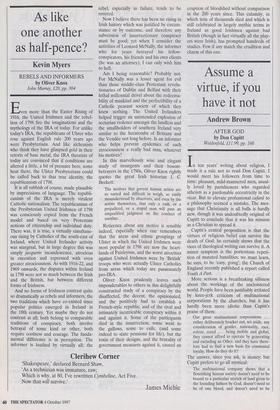As like one another as half-pence?
Kevin Myers
REBELS AND INFORMERS by Oliver Knox John Murray, £20, pp. 304 Even more than the Easter Rising of 1916, the United Irishmen and the rebel- lion of 1798 fire the imaginations and the mythology of the IRA of today. For unlike today's IRA, the republicans of Ulster who rose against English rule 200 years ago were Presbyterians. And like alchemists who think they have glimpsed gold in their retorts of base metal, the IRA theorists of today are convinced that if conditions are altered a little, a bit of pressure here, some heat there, the Ulster Presbyterians could be called back to that true identity, the republicanism of 1798.
It is all rubbish of course, made plausible by imprecisions of language. The republi- canism of the IRA is merely virulent Catholic nationalism. The republicanism of the Presbyterian United Irishmen of 1798 was consciously copied from the French model and based on very Protestant notions of citizenship and individual duty. There was, it is true, a virtually simultane- ous rising by Catholics of the south-east of Ireland, where United Irelander activity was marginal, but in large degree this was simply jacquerie incandescence, atrocious in execution and repressed with even greater atrociousness. As with 1916-22, and 1969 onwards, the disputes within Ireland in 1798 were not so much between the Irish and the British, but between different forms of Irishness.
And no forms of Irishness contrast quite so dramatically as rebels and informers, the two traditions which have co-existed since popular politics emerged in Ireland in the 18th century. Yet maybe they do not contrast at all; both belong to comparable traditions of conspiracy, both involve betrayal of some kind or other, both require coolness and courage. The funda- mental difference is in perception. The informer is loathed by virtually all; the rebel, especially in failure, tends to be revered.
Now I believe there has been no rising in Irish history which was justified by circum- stance or by outcome, and therefore any subversion of insurrectionary conspiracy must be good; yet when I consider the activities of Leonard McNally, the informer who for years betrayed his fellow- conspirators, his friends and his own clients (he was an attorney), I can only wish him to hell.
Am I being reasonable? Probably not. For McNally was a lesser agent for evil than those middle-class Protestant revolu- tionaries of Dublin and Belfast with their lethal millennial drivel about the redeema- bility of mankind and the perfectibility of a Catholic peasant society of which they knew nothing. The United Irelanders helped trigger an unintended explosion of sectarian violence amongst the landless and the smallholders of southern Ireland very similar to the hecatombs of Brittany and the Vendee not long before. Is an informer who helps prevent epidemics of such atrociousness a really bad man, whatever his motives?
In this marvellously wise and elegant study of insurgents and their bosom- betrayers in the 1790s, Oliver Knox rightly quotes the great Irish historian J. C. Beckett:
The motives that govern human action are so varied and difficult to weigh, so easily misunderstood by observers, and even by the actors themselves, that only a rash, or a prejudiced, or a stupid man will pass an unqualified judgment on the conduct of another.
Reticence about any motive is sensible indeed, especially when one remembers that the areas and ethnic groupings of Ulster in which the United Irishmen were most popular in 1798 are now the heart- lands of Paisleyism, and the worst atrocities against United Irishmen were by 'British' troops who were actually Ulster Catholics from areas which today are passionately pro-IRA.
Oliver Knox prudently leaves such imponderables to others in this delightfully constructed study of a conspiracy by the disaffected, the decent, the opinionated, and the positively bad to establish a French-style republic, and of the rival and intimately inextricable conspiracy within it and against it. Some of the participants died in the insurrection, some went to the gallows, some to exile, (and some indeed to state pensions for life), but the toxin of their designs, and the brutality of government measures against it, caused an eruption of bloodshed without comparison in the 200 years since. This calamity, in which tens of thousands died and which is still celebrated in largely mythic terms in Ireland as good Irishmen against bad British (though in fact virtually all the play- ers were Irish), has prompted hundreds of studies. Few if any match the erudition and charm of this one.










































































 Previous page
Previous page